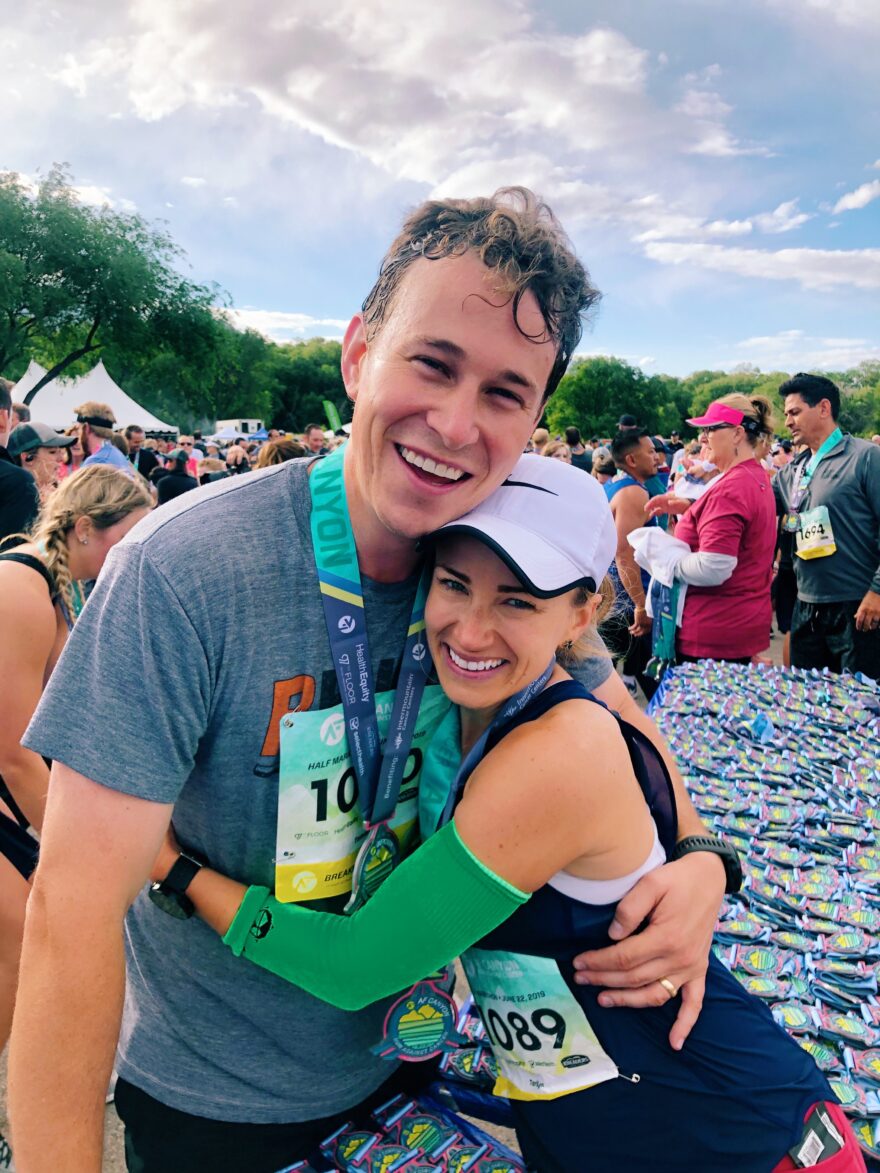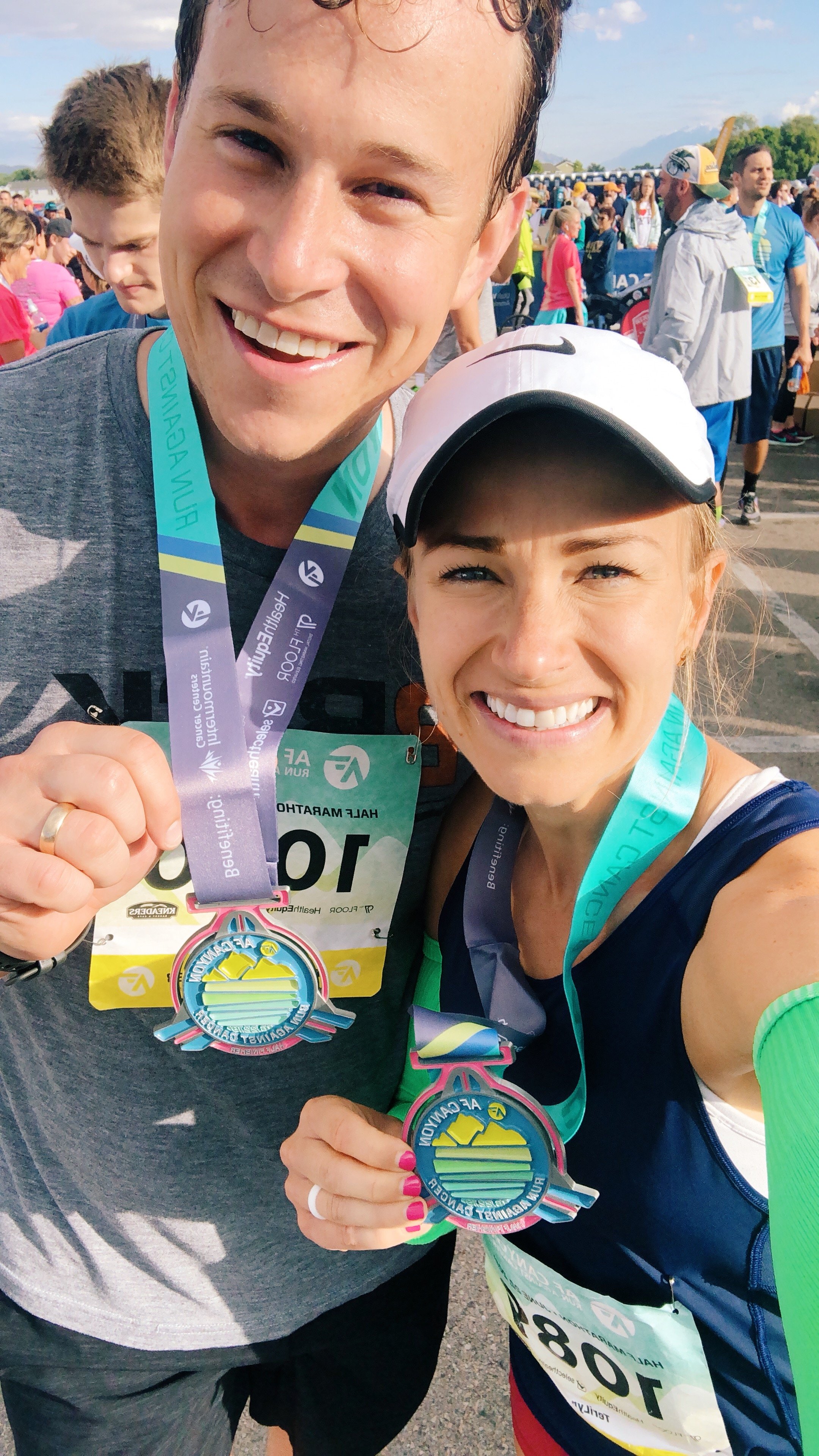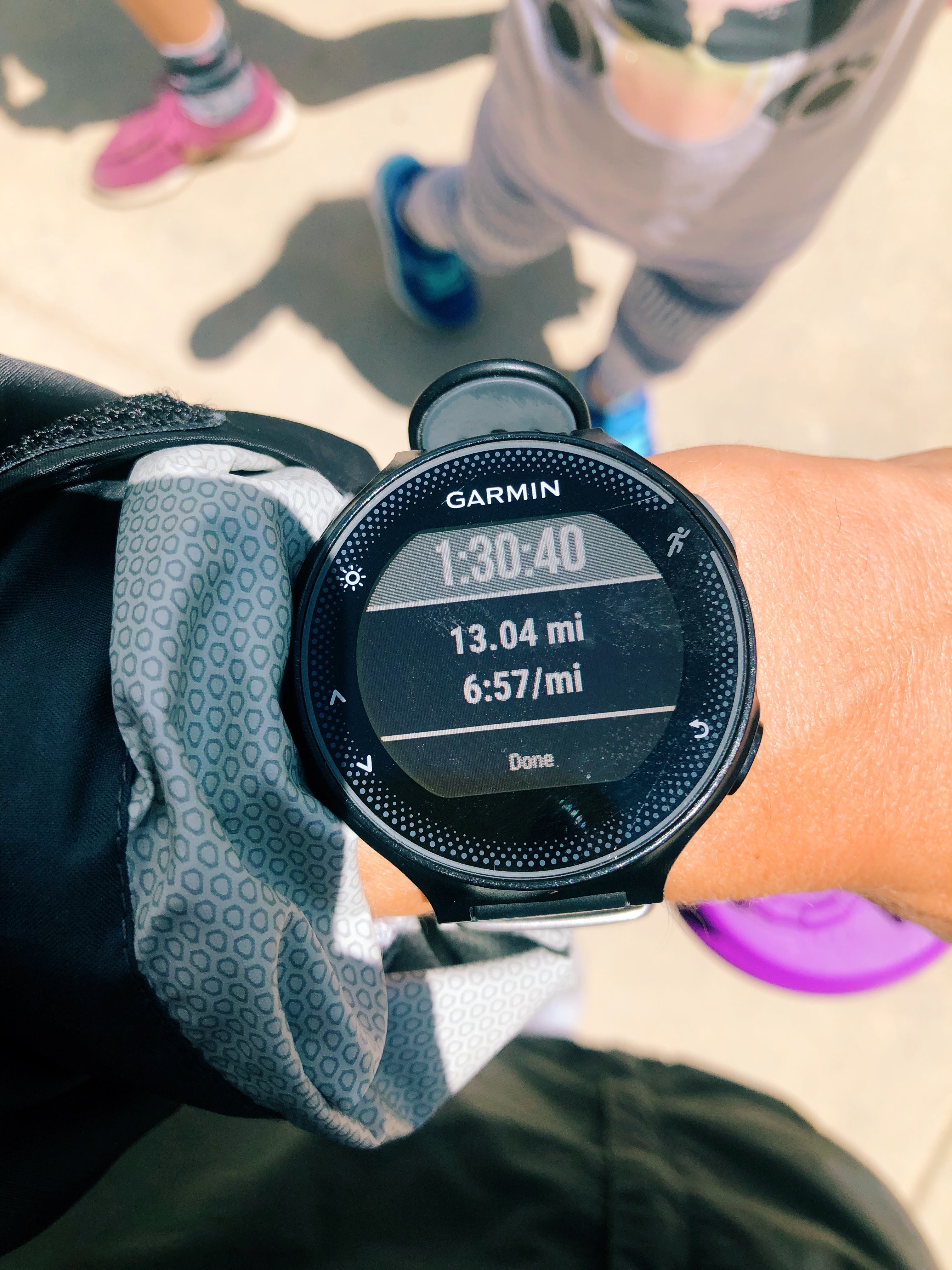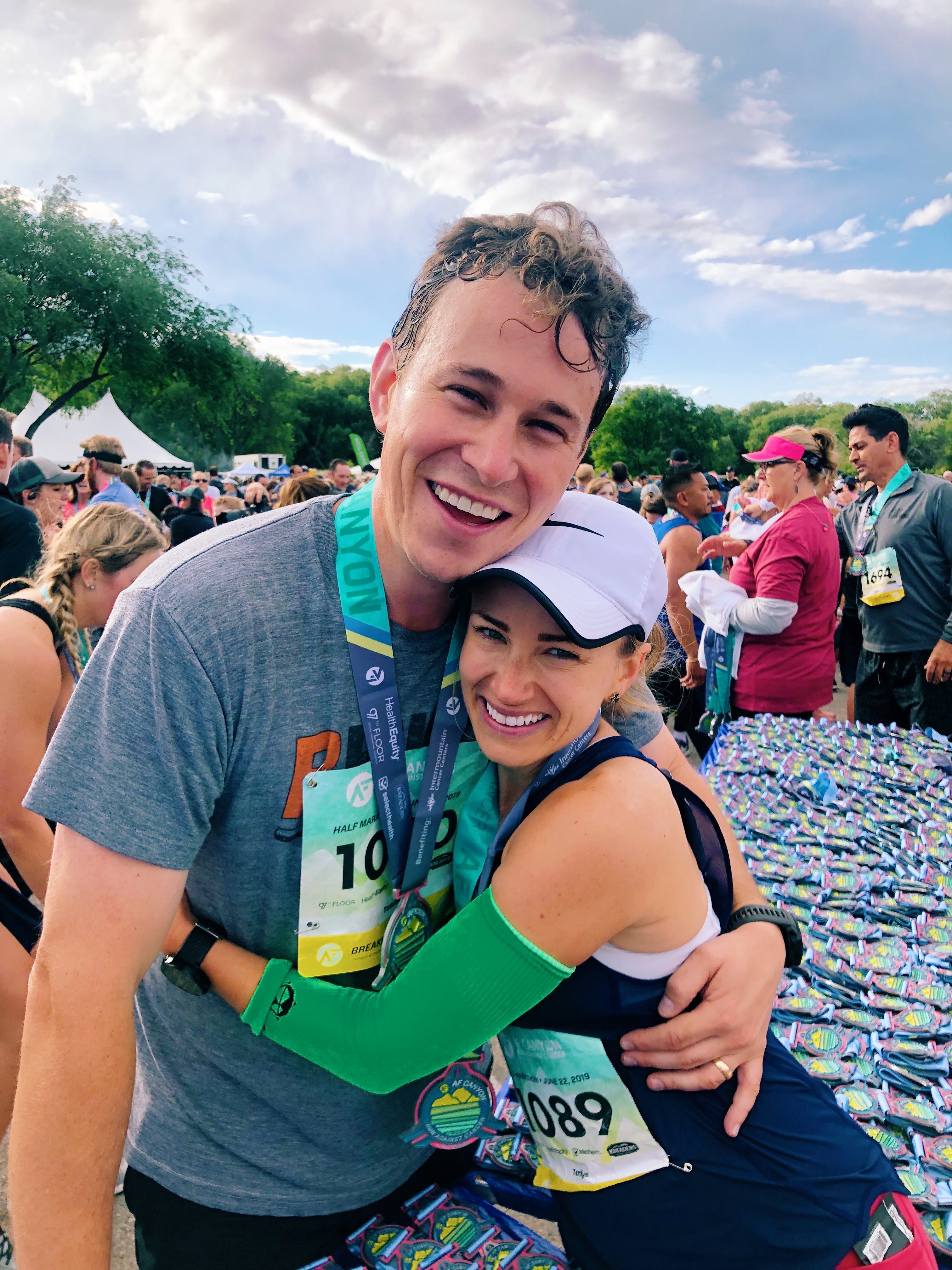


Learn how to train for a half marathon!
I’ve been running for 20+ years, have run over 50 races and the half marathon may be my favorite distance to race. They’re challenging, but they don’t take over your life the way marathon training can. I also like that I can push harder in a half marathon since I don’t have to run as long. I’ve been able to see big improvements in my half marathon time, cutting over 30 minutes off my PR over the years.
Another thing I love about half marathons is that even beginners can do them. In fact, my first-ever race was a half marathon, over 17 years ago! And my husband’s first-ever race was a half marathon too, just a few years ago.
If you’re new to running, here’s a quick overview: a half marathon is 13.1 miles or 21 kilometers. A full marathon is 26.2 miles or 42 kilometers. I’ve been asked multiple times over the years, “How long was your marathon?” when referring to any race, but a marathon is a specific distance — 26.2 miles — and therefore, the half marathon is half that distance.
Today, I’m sharing tried and tested tips about how to train for a half marathon, whether you’re a rookie, intermediate, or a seasoned runner aiming for a new PR at the finish line.
Let’s dive in! Or, I should say, let’s get running!


There are lots of training programs out there for half marathons. You could even consider hiring a running coach, which is what I did for my 2019 Boston Marathon training program. I also have one in my online running course and it’s the exact training plan I wrote for my husband to train for his first half marathon. It is MORE than possible to finish a half marathon with the proper training program, dedication, and a positive mindset. And, it’s very doable to enjoy the miles leading up to race day! Here’s how.
The first thing you should do when training for a half marathon is set realistic goals. Read that again: realistic. If you’ve never been a runner before, going outside and running 13.1 miles will be almost impossible and you may want to start by training for a 5K or 10K. Don’t get me wrong, there are people that do it, but they’re the exception, not the rule (and usually end up injured.) If this is your first time running 13.1 miles, maybe your goal is to finish the race, or to run the whole thing without walk breaks. If you’re a seasoned runner, your goal might be a specific mile time you’d like to average, or an overall time you want to finish under.
Setting goals that are achievable and realistic will help you stay confident during your training versus overwhelmed by the huge obstacle in front of you.
While you’re setting realistic goals, start looking for a training plan that fits those goals. If you’re a beginner, don’t choose an advanced runner’s plan. Start with something that looks doable to you. I recommend looking at the first two weeks of your potential training plan and asking yourself if you think you could complete weeks one and two realistically and not hate your life in the process. If the answer is that you can do those without feeling overwhelmed, you’ve likely got a great plan. If you think weeks one and two look too easy, evaluate why, and pick a different plan. And if they seem too hard, find a run-walk plan.
That’s my advice for experienced runners too! Make sure your plan feels like it’s doable but still challenging. If you can do weeks one and two, you’re likely using the right plan. We go into depth about how to choose the right training plan and how to tailor any training plan to YOUR level and life in my course.
It’s also important to think through what other physical exercise you’re already doing. It’s great to cross-train (cross training is super important for any runner!) while you’re training for a half marathon, but you just want to be careful about what kind of workouts (and their difficulty) they are when you’re thinking through your plan. I recommend doing your strength training workouts on the same days as your running workouts, so that you’re treating your rest days as TRUE rest days.
As a side note: if you aren’t already strength training, it’s a great thing to add to your routine. It reduces your injury risk AND makes you a healthier, stronger runner.
If you’re signing up for an official race, make sure to take into account when and where the race is. If you’re planning to run 13.1 miles outside of your house as an unofficial race, then you’ll be training on your “race course” already. But if not, make sure you train on similar terrain. If your race is a road race, make sure you run on the roads frequently. The treadmill might be great for some workouts, but the majority of your training should be outside.
If it’s a hilly course, incorporate hills into your training. If it’s all downhill, practice that! And if it’s flat, practice flat. If you’re doing a trail race, like I did for my first marathon, make sure you get practice on trails of similar difficulty. Running on different terrain works different muscles and you need to be prepared for your race course by practicing in training.
If your race is in the winter, remember that you’ll have some glorious fall running weather but you will have some cold conditions to train through. Same goes for summer – you’ll enjoy spring running but will have some tough workouts in the heat. For fall races, the bulk of your mileage will take place in the hot summer months. So, don’t avoid conditions (you never know what you’ll get on race day!) and remember that your training may feel different than race day (for better or for harder!).

I can’t emphasize this enough. Rest days are a key part of your training. Somewhere along the line, people started to think that in order to get better you have to run your hardest every single day, which is completely wrong. Make sure your training plan includes recovery days AND complete rest days (they’re different) and respect them as much as you would a tempo run. (If you’re not sure the difference between recovery and rest days or what a tempo run is, my running course would be a great fit for you.
A running base is foundational level of mileage to prepare you for the intensity of a progressive training plan, including increasing mileage and intensity. Basically, you’re getting your body ready for the harder stuff, to help you prevent injury, burnout and to allow you to push harder.
How long it takes to build a base depends on your goal race and training plan, but it can be anywhere from 6-12 weeks. For example, my 2018 Boston Marathon training plan had me start with a base of 30 miles per week. I was already at that mileage so I didn’t need to build up to it before starting my plan. However, the next year, I was coming off a plantar fasciitis injury and needed to build a base before I started training for my next race.
One of the best things about running is that it doesn’t require fancy equipment. The most important thing you need is properly fitted running shoes. While I have my favorite running shoes, I highly recommend that you go to a running store and have them professionally fit you. Skip Dicks Sporting Goods or the like and head to a dedicated running speciality store.
Next most important are socks. You can see my top picks here. And once you have those two things, you just need some sweat wicking clothing! See my favorite shorts for races here and essential running gear for beginners here.
Since half marathon training plans are typically 12-16 weeks, you want to make sure you set yourself up to enjoy your runs! Run with friends on your non-workout days, treat yourself to something yummy after a hard workout, tell friends how your runs are going, etc. Some of my best friends are people I met through running!

There are hundreds of training plans online and they come in all types of difficulty, approaches and complexity. I’ve used a variety of plans over the years. The first half marathon plan that I ever used came from Runner’s World magazine – I tore the plan out and saved it! And I did that for years. Next, I followed training plans from race websites. When I wanted to improve my race plans, I started using Strava training plans, then used one out of this book and even even hired a coach.
When choosing a plan, it’s important to make sure to pick a plan for your goals AND where you are in your fitness journey.
Most training plans range from 10-16 weeks. Choosing a longer plan allows you more time to adapt to the distance you’ll be running, which puts less stress on your body with a more gradual build up.
Compare your training plan to your current training. Look at how many days the plan has you running per week, and compare that to how many days you’re currently running per week. If the plan has you running 5 days and you’re used to running 2, you’ll want a different plan. It’s okay if the plan has you running 1 or 2 days more than you’re used to, but 3 will likely be too rigorous and burn you out.
You’ll also want to look at the mileage it has you running. If you’re used to running 15 miles weekly and the plan starts at 30 miles a week, that’s going to be too aggressive. Look for a plan that has you start at about the same mileage, give or take 10%.
Another thing to note is how many workouts a week your plan includes. If you’ve been doing only steady pace runs, workouts will be new. Look for plans with 2 workouts a week, nothing more. Also check to see how long the long runs are, especially in the first few weeks. If you’ve only run 4 miles, a 10 mile long run in the first 2-3 weeks will be too advanced and likely lead to injuries. And make SURE your plan accounts for easy days and rest day since recovery is essential for all runners!
Your plan should be charted like a schedule so it’s easy to follow, outlining what run to do on each day of the week. While you don’t HAVE to do your long run on a Saturday or Sunday, almost all plans have that listed out since that’s when most people find it most convenient to do their longer runs.
Nutrition for running is something I talk about in depth in my online running course, along with the help of a registered dietitian who specializes in athletic performance. Almost all training plans neglect to talk about nutrition, but it’s one of the most important aspects to training. While there are different types of carbs and some are often labeled “good” and “bad”, in reality, when you’re a runner, all types of carbs have their role. Read more about carbs and running in this post. You can also read about what I recommend to eat before your runs in this post.
Here are a few guidelines.
You need carbs while training for a half marathon and probably more than you think since carbohydrates are the body’s most efficient energy source for exercise. When we’re running, most of our fuel comes from the stored fat and carbohydrate that’s in our body. Those stored fats and carbohydrates come from the food we ate prior to the run (it can come from a few days prior, not just the meal directly before). For example, if you eat a meal high in carbs right before you run, then you’ll burn a higher proportion of carbohydrates during the workout. This is particularly useful for speed work.
To fuel longer runs, you’ll want to combine carbohydrates with protein and fat to help keep hunger at bay. A meal complete with macronutrients can help delay the onset of fatigue, improve endurance and performance.
This post explains the types of carbs you need at various points in your training in more detail.

Hydration is key to training success. You’ll need to be drinking more water than you’re likely used to drinking but water alone isn’t enough. You need electrolytes. I love LMNT in my water bottles for ALL summer runs (in addition to lots of ice!), as well as longer runs in the cooler months. Most electrolyte supplements are a blend of sodium, potassium, magnesium, calcium, and sodium bicarbonate. That blend helps regulate nerve and muscle function and maintain your water balance. In turn, that means you can run longer and stronger and recover better afterwards. LMNT has the benefit of a traditional sports drink with electrolytes, but isn’t loaded with sugar, tastes MUCH better and never leaves my gut feeling like it got massaged by sandpaper like Gatorade does.
I cut out alcohol when I’m training for a big race. Not everyone does this, but I find that it really helps my body to cut that out when I have a big goal. And then after the race, I reward myself.

When choosing a pre run or pre race meal, think about what type of run you’re doing. If it’s a long run, make sure you pair your carbohydrates with some protein and fat (e.g. toast with peanut butter or a couple of energy balls). If it’s a more intense workout with intervals or tempo miles or race day, you’ll want a higher ratio of carbs in your pre-run meal (e.g. toast with honey, oatmeal with raisins, etc.). That’s not to say you shouldn’t have any fat or protein in your pre-run meal if you’re doing speed work. But, you do want more carbs.
Both fat and protein slow down the digestion and absorption of carbs, which can cause discomfort if you run directly after. However, both are still really important to include in your pre-race meal to help you feel full, and steady to release of glucose to the bloodstream, so the key is making sure you digest before running. Stick to eating your pre-race meal about 90 minutes prior to racing or running.
I typically I eat breakfast around 2-3 hours before the start of a long run or race, and then a smaller snack, like a banana, closer to the start of my run. Whatever you choose to eat the morning or your race, the most important thing is that you practice it! Eat it before your long run days and races in the lead up to your goal half. Same goes for coffee. If you need coffee in the morning to feel alive, make sure you practice drinking it before long runs so that you know how long you should wait before beginning your run. There’s nothing worse than having to dash to the restroom at the starting line. And make sure to hydrate during the days leading up to your run, especially the day before.

Okay, now get out there and enjoy your running!
My running essentials


Leave a Comment